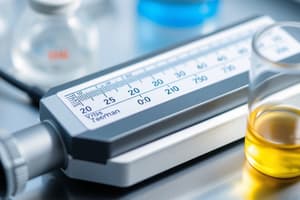Podcast
Questions and Answers
What is a key characteristic of a liquid?
What is a key characteristic of a liquid?
- It can flow and take the shape of its container. (correct)
- It cannot be compressed.
- It has a fixed shape and volume.
- It maintains a constant volume regardless of temperature.
Which of the following is a physical property of liquids?
Which of the following is a physical property of liquids?
- Density (correct)
- Chemical reactivity
- Flammability
- Toxicity
Why is studying the physical properties of liquid materials important?
Why is studying the physical properties of liquid materials important?
- To determine their color and odor.
- To identify and check the quality of raw materials and finished products. (correct)
- To measure their weight and volume.
- To understand their chemical composition.
What is density defined as?
What is density defined as?
What happens to the density of a substance when the temperature increases?
What happens to the density of a substance when the temperature increases?
How does an increase in pressure typically affect the density of a substance?
How does an increase in pressure typically affect the density of a substance?
Which of the following instruments is known for providing a more accurate measurement?
Which of the following instruments is known for providing a more accurate measurement?
What is relative density (specific gravity) defined as?
What is relative density (specific gravity) defined as?
What is the first step in the experimental work for measuring density?
What is the first step in the experimental work for measuring density?
After washing, how should the flask be dried in the experiment?
After washing, how should the flask be dried in the experiment?
In the density experiment, what does 'W1' represent?
In the density experiment, what does 'W1' represent?
What does W4 represent in the calculation?
What does W4 represent in the calculation?
What formula is used to calculate specific gravity?
What formula is used to calculate specific gravity?
If you know the relative density of glycerol and the absolute density of water, how do you calculate the absolute density of glycerol?
If you know the relative density of glycerol and the absolute density of water, how do you calculate the absolute density of glycerol?
What is the value of $d_{H_2O}$?
What is the value of $d_{H_2O}$?
Which of the following is NOT a physical property?
Which of the following is NOT a physical property?
Which of the following is an advantage of using a Pyknometer?
Which of the following is an advantage of using a Pyknometer?
What formula represents the calculation of liquid?
What formula represents the calculation of liquid?
What is the result of relative density?
What is the result of relative density?
What happens to liquids exposed to high temperatures?
What happens to liquids exposed to high temperatures?
Flashcards
Liquid
Liquid
A chemical substance that can flow and take the shape of its container.
Density
Density
Mass per unit volume of a substance. D = m/V (g/cm³ or Kg/L).
Specific Heat Capacity
Specific Heat Capacity
The amount of heat required to raise the temperature of a substance.
Viscosity
Viscosity
Signup and view all the flashcards
Surface Tension
Surface Tension
Signup and view all the flashcards
Boiling/Freezing point
Boiling/Freezing point
Signup and view all the flashcards
Refractive Index
Refractive Index
Signup and view all the flashcards
Relative Density (Specific Gravity)
Relative Density (Specific Gravity)
Signup and view all the flashcards
Instrument for accurate liquid density measurement.
Instrument for accurate liquid density measurement.
Signup and view all the flashcards
Measuring Flask
Measuring Flask
Signup and view all the flashcards
Study Notes
- Liquid is a chemical substance or component that can flow and take the shape of any container, like H2O.
- Liquids possess various physical properties.
- Physical properties of liquids include density, viscosity, specific heat capacity, refractive index, surface tension, and boiling/freezing point.
- Studying the physical properties of liquid materials is vital for industries to identify and check the quality of raw materials and finished products.
Density of Glycerol
- Density is the amount of mass in a unit volume of a substance.
- Density is expressed as D = m/V, where units are g/cm³ or Kg/L.
- Temperature and pressure affect density:
- As temperature increases, density decreases.
- As pressure increases, density increases.
Instruments for Measurement
- Pyknometer is used for accurate measurement.
- Measuring flask is also used for volume measurement.
Relative Density (Specific Gravity)
- Relative density of a liquid is the absolute density of the liquid divided by the density of water at the same temperature and it is a dimensionless quantity.
- d relative = d liquid/dH2O = (W/V) liquid / (W/V) H2O
- If the volume of liquid equals the volume of water, then d relative = W liquid/W H2O
- d liquid = d relative X d H2O
Experimental Work
- Wash the flask with tap water and distilled water.
- Dry the flask with ethanol, followed by ether, and then with a jet of dry air.
- Weigh the empty flask (W1)
- Fill the flask with water to the mark and weigh it (W2)
- Remove the distilled water, rinse with a small amount of glycerol, fill to the mark with glycerol, and weigh it (W3).
Calculation
- Weight of water: W4 = W2 (flask + water) - W1 (flask only)
- Weight of glycerol: W5 = W3 (flask with glycerol) - W1 (flask only)
- Specific gravity: d relative = W liquid/W H2O = W5/W4
- Absolute density of glycerol: d glycerol = d relative X d H2O
- The absolute density of water d H2O = 0.99626 g/cm³
Studying That Suits You
Use AI to generate personalized quizzes and flashcards to suit your learning preferences.




